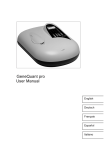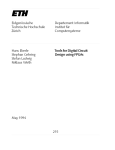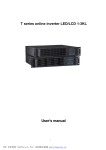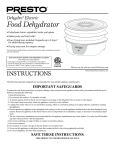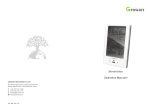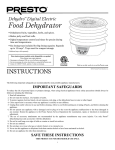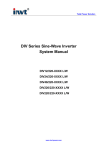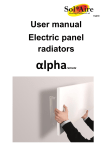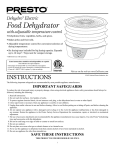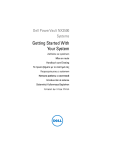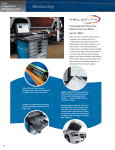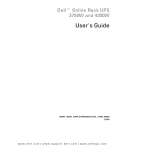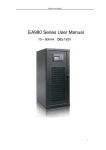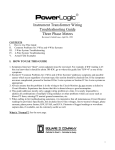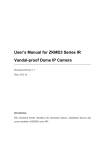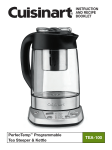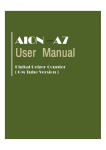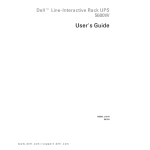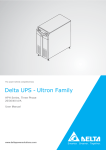Download User`s Manual - Lanches
Transcript
User’s Manual ( DSP ) UNINTERRUPTIBLE POWER SUPPLY 1 Caution Please strictly comply with the manual operation instruction, and keep the manual well. Make sure read the manual carefully before use! Non-professional technicians are prohibited to open the unit casing in case of electric shock, as the input and output of the unit have high voltage, it may endanger your safety. Make sure the units connect with ground well when installing. Close up all switches for 5 minutes before opening the unit casing for maintenance. Do not touch the electrolyte flooded from the damaged battery, as the electrolyte is corrosive. The unit battery should keep same brand and same type. Forbid mixed-using different battery from different manufacturers. The unit is class “A” product; it may cause radio interference on environment. Do not try to change the unit configuration; it may affect the unit performance. Operate the unit within the specified voltage range. Prevent unit from insulation, drenching or shaking. Do not install the unit in the environment of flammability, explicability or corrosiveness and electric dust. Only professionals can installs and maintain the unit. 2 Content 1 SYSTEMS...................................................................................................................................... 5 1.1 Brief Introduction ................................................................................................................ 5 1.2 System Configuration ......................................................................................................... 5 1.3 Working Mode .................................................................................................................... 6 1.4 Function and Features ......................................................................................................... 8 1.5 Technical Specifications ...................................................................................................... 9 2 INSTALLATION ......................................................................................................................... 10 2.1 Environment Selection ...................................................................................................... 10 2.2 Placement .......................................................................................................................... 10 2.3 Unpacking ......................................................................................................................... 11 2.3.1 Accessories ............................................................................................................. 11 2.3.2 The specification item checked ............................................................................ 11 2.4 Configuration & Dimension ............................................................................................ 12 2.5 The selection of air circuit-breaker and cable ................................................................... 12 2.5.1 The selection of air circuit-breaker ........................................................................ 13 2.5.2 Cable selection ........................................................................................... ………13 2.6 Instruction of input and output terminals .......................................................................... 13 2.7 Installation instruction of single unit................................................................................. 14 2.8 Installation introduction of hot-standby in series connection............................................ 15 2.8.1 Make the slave UPS’s input connect to the master UPS’s bypass input, then it becomes a hot-standby system. See figure 2.4 ................................................................ 15 2.8.2 Hot-standby cable connection ................................................................................ 15 2.8.3 Hot-standby working pinciple ................................................................................ 16 2.9 Installation Inspection ....................................................................................................... 17 2.9.1 UPS inspection ....................................................................................................... 17 2.9.2 Electric inspection .................................................................................................. 17 3 ON/OFF OPERATION ................................................................................................................ 17 3.1 Preparation before switching on the UPS ......................................................................... 17 3.2 Single UPS starting steps . ................................................................................................ 17 3.3 Single UPS shutdown steps ............................................................................................. 18 3.4 Hot-standby system starting steps ..................................................................................... 18 3.5 Hot-standby system shutdown steps ……………………………………………………18 3.6 Emergency power off steps. .............................................................................................. 18 3.7 Maintenance operation steps ............................................................................................. 18 4 Operation of front panel ............................................................................................................... 19 4.1 The configuration & function of front panel ..................................................................... 19 4.2 Setting instruction ............................................................................................................. 19 4.3 Display information .......................................................................................................... 20 5 Communication Interface ............................................................................................................. 23 3 5.1 RS232 instruction .............................................................................................................. 23 5.2 RS485 Instruction ............................................................................................................. 23 5.3 USB instruction:................................................................................................................ 24 5.4 Dry-Contact instruction ..................................................................................................... 24 5.5 SNMP instruction .............................................................................................................. 24 5.6 EPO interface .................................................................................................................... 24 6 Daily Maintenance ....................................................................................................................... 24 6.1 Battery use and maintenance ............................................................................................. 24 6.2 UPS maintenance .............................................................................................................. 25 6.3 Maintenance safeguard...................................................................................................... 25 6.4 Trouble shooting ............................................................................................................... 25 6.5 Package, shippment and storage. ...................................................................................... 26 6.5.1 Package .................................................................................................................. 26 6.5.2 Shippment .............................................................................................................. 26 6.5.3 Storage ................................................................................................................... 27 4 1 SYSTEMS 1.1 BRIEF INTRODUCTION DSP series UPS are mainly applied to computers, data center, and administration center of networks, precision instruments ect. Providing high reliable AC uninterruptible power supply. The UPS, equipped with dual-conversion design with output isolation transformer and advanced complete digital control technology, keep on providing the load with clean uninterruptible power with stable voltage and frequency when the mains off. 1.2 SYSTEMS CONFIGURATION Bypass input FI TER REC PFC I NV AC input Battery DSP series UPS is composed of input & output switches, input & output EMI filter, rectifier, inverter, output transformer, static switches, battery, maintenance bypass switch ect. The main circuit of input power goes through air breaker, and comes cross input EMI filter to reach the rectifying units. After rectifier transfers AC power to DC power, it gets into PFC circuit to improve UPS input power factor. The partial circuits adopt delayed soft-start and PFC control technology to improve system’s impact resistance and input power factor as well as greatly decrease the harmonic pollution to electricity. Battery is connected to UPS by switch and contactor, and through PFC boost voltage to DC BUS voltage, the contactor pull in only when the DC Bus voltage gets to a rated value. The battery supply DC power to inverter via the PFC circuit. Bypass input power through air breaker inputs and controls the output by static 5 bypass switch. The whole system completely adopts digital DSP control. All of UPS inverter control, phase synchronization, input rectifier control and logic control ect adopt DSP digital signal manager, which has high precision, fast speed, easy circuit and high reliability. The system has the following working modes. 1.3 Working Mode Normal working mode Bypass input FI TER REC PFC I NV AC input Battery Figure1.1 Normal working mode Figure 1.1,when the mains is normal, the input AC power is inverted by rectifier, then the UPS will provide load with pure and stable AC power through output static switch, meanwhile, the UPS charges the battery. Battery working mode Bypass input FI TER REC PFC I NV AC input Battery Figure1.2 Battery working mode Figure 1.2,When the mains is abnormal or inverter failure, the UPS input rectifier is off and the DC power from battery is supplied to inverter. And then the UPS output pure 6 and stable AC power to load through static switch. At this time, UPS stops charging the battery. Bypass working mode Bypass input FI TER REC PFC I NV AC input Battery Figure1.3 Bypass working mode Figure 1.3,when the inverter is abnormal, such as overload, over temperature, short-circuit or failure, UPS will turn off the inverter automatically and turn on the bypass static switch and then the bypass will supply the power to load. At the same time, UPS is unable to provide uninterruptible protection to the load and the power is just supplied by AC from the bypass. Maintenance working mode Bypass input FI TER REC PFC I NV AC input Battery Figure1.4 Maintenance working mode Figure 1.4,When UPS is under the situation of reparation or maintenance, in order to make sure keep providing continuous power supply to the load, the user should make the UPS turn to bypass working mode and turn off maintenance bypass switch, then turn off the UPS input/output switch and battery switch, therefore the UPS will enter into 7 maintenance mode, shows as the arrow indicated in the figure. It is safe to repair the UPS as there is no electricity in the inner UPS at this time. 1.4 Function and Features 1.Advanced DSP digital control technology the inverter control, phase synchronization, input rectifier control, logic control ect… all adopts DSP digit signal technology with high precision, high speed, high reliability. 2. High input power factor, green energy-saving power Input power factor reaches up to more than 0.98; the total harmonic distortion of input current THDI<5%; it greatly decreases distortion pollution from UPS to the electricity , increase the mains usage and reduce installation cost. 3. Wide input voltage and frequency range Wide input voltage and frequency range can decrease battery’s frequent charging time, make good use of battery. It also has strong ability to adapt electricity so that the motor can be easily connected. 4. Abundant interface setting function Through the buttons on the front panel, the user can set up output voltage and rated frequency, so that the UPS can be applied to different voltage and frequency. 5. Excellent network monitor function Provide with RS232, RS485, SNMP, USB, dry contact interface, support TCP/IP protocol. The user can monitor UPS working status on-line neglecting the distance, and make the UPS execute self-test procedure, time sending inquiry, send E-MAIL, as well as automatically save computer data and turn off the computer safely. 6. Big LCD display There is an option for user to choose the Chinese or English LCD display, it can display the UPS working parameter and status, faults alarming information and history records, it is very convenient for daily management and maintenance. 7. Perfect protection UPS has input low / over voltage protection, output low / over voltage protection, overload protection, short-circuit protection, overheat protection; ECO protection, surge protection ect. it can make sure that the UPS can work well under different environment. 8. Cold start and AC start function When there are no mains, UPS can start by the battery; or when there is no battery, UPS can start by the mains. To meet user’s needs, when the battery is discharging to 8 low-voltage protection, it can automatically start the UPS when the mains recover. 9. Easy for maintenance Designed with manual bypass maintenance, the load can still have power supply when the UPS is in maintenance, it is convenient for users, and it also improves usability and maintainability of the system. 1.5 Technical Specification Model 8806 8810 38810 Rated capacity 6KVA 10KVA 10KVA Working mode and principle Configuration Input power factor Rated voltage Input voltage range Rectifier input Bypass input charge Rated frequency Input frequency range Current harmonic distortion AC output System 38830 30KVA Online, static bypass switch(uninterruptible transfer), dual-conversion technology Single phase input , single phase output >0.99 220/230/240VAC 120V-285V at half load;160V-285V at full load Three phase input and single phase output >0.95 380/400/415VAC 210V-495V at half load; 280V-495V at full load 50Hz/60Hz 40—70Hz <5% —— 0~100% 15—20sec Input voltage range 187~253V Frequency trace range ±5% Floating voltage 220VDC Charge current 8A Input/output over voltage protection, short-circuit protection, over temperature protection ect. Maintenance-free sealed lead-acid battery 16pcs of 12V battery connected in serial 192VDC 0.8 L+N+G 200/208/220/230/240VAC 50Hz/60Hz, settable <±0.1Hz(in battery mode) <±1%(stable) 3:1 Linear load<3% 105%~125% load for 10min ;125%~150% load for 1min; >150% load for 1s AC—battery:zero transfer;bypass—inverter:zero transfer Interval for 4S,beep for 1S;after 1min, beep stops automatically Interval for 1S,beep for 1S;beep continuously Interval for 4S,beep for 2S;beep continuously Continuous beeps LED+LCD Output short-circuit, overload, output over voltage or low voltage, battery low voltage, over temperature RS232,USB(Standard),RS485,SNMP(Optional) type quantity Rated battery voltage Power factor phase Rated voltage Rated frequency Frequency precision Voltage precision Output current crest Wave distortion Overload capacity Alarm 38820 20KVA Soft start protection battery 38815 15KVA Transfer time AC abnormal Battery low voltage Overload alarm Failure alarm display Protection function Communication port 9 Operation temperature Relative humidity Cooling Noise dB Input/output Surge protection Electromagnetism compatibility configuration Weight(Kg) others Weight and packing Dimension(W×H× D)mm 0~40℃ 0~90% (non-condense) Intelligent fan speed adjustable <60- 1M Terminal IEC60664-1 grade protection <55 -1M- Comply with GB7260.2-2003 68 128 260×780×590 325×951× 690 Tower type, IP30 176 218 353×1030× 805 258 300 520× 1280× 877 400×1152×860 The specifications may be changed without prior notice! 2 INSTALLATION 2.1 Environment Selection ◆Working Temperature:0-40℃ ◆Storage Temperature:-40-70℃(without battery) -20-55℃(with battery) ◆Relative humidity:5%~95%,Non condensing ◆Altitude:1500m,meets to GB3859.2-93 requirement ◆The tolerance of uprightness:No vibration bumps and the vertical gradient should be no more than 5 degrees. The environment for UPS installation should be with adequate ventilation, cool, low humidity and no dust. Recommended working temperature is 20~25℃, humidity is about 50%. UPS should work in the place with the altitude below 1000m; when the altitude is above 1500m, it is recommend that operate UPS according to below descending table. Altitude(m) 1500 2000 2500 3000 3500 4000 4500 5000 Descending coefficient 100% 95% 91% 86% 82% 78% 74% 70% 2.2 Placement The provided AC power capacity must meet the requirement of UPS normal working. Please use unique input and output air switch for UPS, don’t share the same air switch with other equipment. Install UPS as close as possible to the AC power outlet. 10 The floor board which takes the UPS weight should be strong enough. Any other dangerous installation is forbidden. No storage of flammable, explosive and other dangerous goods in the place and fire equipment is required. Keep good ventilation around UPS, don’t obstruct the cooling channels. Keep each side of the UPS at least 1 meter away from the wall so that there should be enough space for future maintenance and operation. It is recommended that there should be a professional for UPS house management, non-professional is forbidden to enter in. 2.3 Unpacking Before unpacking, inspect if the packaging is damaged during the transport and if it is the correct model you ordered. After unpacking, check if all the accessories are included and if the real product is right. 2.3.1 Accessories User manual, 1pc; CD for monitoring software, 1pc; Cables for RS232 and USB interface, each 1pc; 2.3.2 The items of UPS specification should be checked UPS Capacity;the voltage of input and output、frequency;the phase of input and output;Battery voltage. 11 2.4 Dimension of structure and instruction LI NE BYPASS BAT. I NV. ESC FAULT ON/ OFF SCREEN ENTER Figure2.1 Drawing of structure As the UPS has the ventilation holes in the front side, back side, right side and left side as long as the bottom, please make sure there is enough space so that the air can flow. BYPASS BAT. I NV. ESC FAULT ON/ OFF SCREEN ENTER RS232 RS232 USB EPO( Emer gency Power OFF) BAT. LOW AC FAULT I NTELLI GENT SLOT LI NE Fr ont Panel I nt el l i gent Sl ot Fr ee Cont act USB BYPASS OVER LOAD FAULT EPO. 485+ 485GND SI NGLE MODE f an Par al l el Por t PARALLEL PORT Bat t er y Br eaker Bypass Br eaker AC Br eaker Out put Br eaker Manual Bypass Br eaker Ter mi nal PE I NPUT E N L BYPASS JP1 JP2 BATTERY OUTPUT PE + L E - N Figure2.2 Layout of full unit 2.5 The selection of Air circuit-breaker and cable The cable for different capacity of UPS has different grade, unsuitable cable or air 12 circuit-breaker will cause dangers. The selection principle is: 3-5A/mm2 for middle and small size UPS, 2.5-3A/mm2 for big power UPS. Meanwhile, note that the maximum voltage for the power cable not more than 3V is better. There are input neutral wire for bypass and output neutral wire for UPS power system. For three phases in and one phase out UPS, the cross-sectional area of input null line should be 1.5-1.7 times of phase line. UPS system has safe protection for grounding and lightning protection, their cross-sectional area should be 0.5-1.0 times of phase line and no smaller than 6mm2 2.5.1 The selection of air circuit-breaker POWER Input voltage Output voltage Input Output Input air Output air KVA VAC VAC Max.current(A) Max.current(A) switch (A) switch (A) 4 220 220 32 18 50 32 6 220 220 44 27 63 40 8 220 220 55 36 80 50 10 220/380 220 66 45 100 63 15 380 220 94 68 125 100 20 380 220 122 90 150 125 30 380 220 177 136 200 160 Note: Forbid using creepage protection type switch 2.5.2 Cable selection 10KV 10KVA(3: 15KVA(3: 20KVA(3: 30KVA(3: Wire mm2 A Wire mm2 1) Wire mm2 1) Wire mm2 1) Wire mm2 1) Wire Mm2 8 10 16 6 6 8 16 6 6 8 10 10 16 25 35 s Output 6 6 8 10 10 16 25 35 Battery 6 8 10 10 10 16 25 35 Neutral 6 8 10 16 10 16 25 35 Earthin 6 6 6 6 6 6 6 8 4KVA 6KVA 8KVA Wire mm2 Wire mm2 Input 6 By-pas Model g Note:The real cable should be no smaller than the figures in above table 2.6 Instruction of input and output terminals The terminal is on the rear panel, see below figure for details on terminals plate: 13 E N L PE I NPUT JP1 + JP2 BYPASS - L BATTERY N E OUTPUT PE Figure2.3 Single phase 4~10K terminal drawing Figure2.4 three phase in one phase 10K/15K/20K out terminal drawing 2.7 Installation instruction of single unit E N L JP1 JP2 + L N E LOAD AC INPUT Battery - Figure2.5 Single phase 4~10K terminal connection drawing 14 Figure2.6 three phase in one phase out 10K/15K/20K terminal connection drawing 1)JP1, JP2 must be short connected with 10mm2 wire when operate a single UPS. 2)Anode, cathode of battery and live wire, neutral wire cannot be connected in reverse. 2.8 Installation introduction of hot-standby in series connection. 2.8.1 Make the slave UPS’s input connect to the master UPS’s bypass input, and then it becomes a hot-standby system. See figure 2.7 Mast er UPS Sl ave UPS AC i nput Bypass Load REC I NV Figure 2.7 2.8.2 Hot-standby cable connection Sl ave UPS E N L AC i nput JP1 JP2 + - Mast er UPS L N E E Bat t er y1 N L JP1 JP2 + - Bat t er y2 15 L N Load E Figure 2.8 Single phase hot-standby connection diagram Figure 2.9 Three phase hot-standby connection diagram Connect the neutral, line, earth of the mater and slave in parallel, and make the output line of slave connected to input of the master(JP2)(JP2), and output neutral and earth in parallel, and loads will be at the output of the master. 2.8.3 Hot-standby working principle Normal working mode: Sl ave UPS Bypass AC i nput REC Mast er UPS Bypass I NV Load Load REC I NV Figure 2.10 Normal working flow Figure 2.10 stands for system normal, power is supplied by the master UPS, and the slave UPS works at “0” load status. Once the master UPS is failed, the master will transfer to bypass and then the slave UPS provides the power. See Figure 2.11 Sl ave UPS Bypass AC i nput REC Mast er UPS Bypass I NV Load REC Figure 2.11 Master UPS abnormal working flow 16 I NV 2.9 Installation inspection 2.9.1 UPS Inspection After UPS installation, please do the necessary inspections as below: Whether the UPS trucke brake fixed or steady or skew. Whether the UPS scraped or hit damage. Whether there are sundries around the UPS body or around it. 2.9.2 Electric inspection After UPS switching finished, please inspect following items: The input and output switching is ok and the in and out terminals are canonical Make sure the input and output connected cable steady,phase series correct and mark complete. Make sure battery cable connection fastened, polarity normal and battery setted steady. Make sure the cable laying of system canonical, neat and easy for future inspection and extendable. 3 ON/OFF OPERATION 3.1 Preparation before switching on the UPS Reconfirm if all connection and power supply are correct before start-up. Inspect the input voltage and frequency is within the range. All UPS switches are at off mode. 3.2 Single UPS Starting steps Turn on the AC input switch. Then the power supply board starts to work and the LCD will display “LINE and “BAT” lights on, reminding to select the language and going into standby status. Turn on battery switch and UPS recharges the batteries with small current. 1) UPS Starting Long press ON/OFF button above 1second, LCD display “starting in process,please wait…”, about 10seconds later on, UPS transfer to inverter output and “INV” light on, “BAT ”off. 2) Turn on bypass switch. 3) Turn on output switch. 17 3.3 Single UPS shutdown steps 1) Shut off output switch. 2) Shut off the UPS. Long press ON/OFF button above 1second. 3) Shut off battery switch. 4) Shut off bypass. 5) Shut off AC input switch 3.4 Hot-standby system starting steps Firstly start the slave UPS( the Standby UPS). Starting steps as same as single UPS. Then turn on the master UPS. Starting steps as same as single UPS. 3.5 Hot-standby system shutdown steps ●Turn off the master first. Turn off steps as same as single UPS. ●Then turn off the slave UPS. Turn off steps as same as single UPS. 3.6 Emergency power off steps When meet emergency affairs, users should shut off all power supply at once and shut down all the switches at the same time. 3.7 Maintenance operation steps This step must be done by professional people. Turn off the inverter. Press the ON/OFF longer than 1 second, and UPS will transfer to bypass and the bypass light will illumine. 1) Open the rear cover board of the breaker; turn on the manual bypass breaker. 2) Shut off UPS input switch, battery switch, bypass switch and output switch. 3) Do UPS maintenance 4) Turn on the output switch. 5) Turn on the bypass switch, input switch, battery switch and bypass light will be on. 6) Shut off manual maintenance switch. 7) Switch on the inverter. Press the ON/OFF longer than 1 second, and 10s later, UPS goes into normal working status. 18 4 Operation of front panel 4.1 The structure & function of front panel ( 1) ( 4) ( 5) ( 6) ( 2) ( 3) LI NE ( 7) ( 8) BYPASS BAT. I NV. ESC FAULT ON/ OFF ENTER SCREEN ( 10) ( 9) (1)LCD display screen. Display the working parameter and status of the UPS. (2)Bypass output indicator (green). It will light when UPS output is in bypass model. (3)Main power input indicator (green). It will light when main power is normal. (4)Battery is working (yellow). It will light when battery supply power to UPS. (5)Inverter output indicator (green). It will light when the Inverter is working. (6)Error alarm indicator (red). It will light with alarm when UPS has fault. (7)“Back” Press. this button to back to last step or exit, or cancel the parameter setting. (8)—“Screen”. To view and choose the functions or items. (9)—“Enter”. This button is to confirm where the cursor points or the parameter setting. (10)—“ON/OFF”. Press it longer than 1 second, the UPS will start or turn off. 4.2 Setting instruction Choose the language: When UPS is in “Sleep” model, press “ENTER” to enter the Home Page, and press “Screen” and choose “System setting”, then press “Enter” to choose “language setting”, after choose the Language that you needed, press ENTER to confirm. 19 4.3 Display information 1) Turn on the A/C input switch, LCD will display as below:. EAST G RO U P Welcome to 易 易 易 易ON-LINE 易 易 易UPS 易 易 易 易 易 易 3 seconds later, the system will enter the “Standby Mode” as below: O/P 000 O / P VOLT: V O LT : O/ P O/P 0V0 0 0 0 . 0 HZ FRE Q : FREQ: 00. 0 O/ P V LO A D : HZ 00 0 % A N D%B Y MO DLOAD: E : S T000 O/P MODE: Standby 2) Press the ON/OFF button for over 1 second, UPS will enter starting model. UPS EAST UPS UPS TO ON U PINS PROGRESS TO O N I NPLEASE P R O GWAIT RE S S . . P L E A S E WA I T 3)10 seconds later, UPS will transfer to Inverter output, the “sleep” model become “main power model” 4) Press” Enter” to enter “Function Menu” 20 STATUS S T AT U S MODEL INFO SETUP MOD E L I NFO Version: Ver2.8 5) Select “parameter setting” and press “Enter” to check parameters OUTPUT DATA OU T P U T INPUT DATA I N PU T BATTERY DATA DC D ATA D A TA BAT T E R Y DAT A LINK DATA DC L I N K DA TA 6) Select “output parameter” and press “enter” to check the parameter of output. VOLTAGE: 000 FREQ: 0 0 . 0HZ VO LT AGE : V 00 0 V F R EQ : 0 0 . 0 HZ LOAD: 000 % LO A D : CURRENT: 000 0A0 0 % C UR R ENT : 00 0 A WA T T : WATT: 0 0W 0 00000 00W VA: VA : 0 0000000VA 0 0 VA 7) Press “ESC”, the window will be back to last page, select “model info” and press “Enter” ⑴4-10KVA single phase UPS 21 LINE VOLT L I NE V O L: T : 0000 00 V FREQ: F R EQ : 0 00 0.. 00HZ HZ C U RR E N T : 00 0 A (2) 10-30KVA three phase input and single phase output R-N: V : 00 0 V L I N E 0V0O0 L T S-N: 000 V 0 0 . 0 HZ F R EQ : T-N: 000 V 00 0 A C U RR E N T : FREQ: 0 0. 0 HZ 8) Or you may select “battery parameter” and press “Enter” to check the battery status. BAT VOLT: 000 V BA T V O L T : 0 0 0 V 9) Or you may check the UPS inner DC Bus voltage BUS B U SVOLT: 0 V O LT :0 0 00 0 V V 10) Press “ESC” to return to the last step, press “Input the parameter” and “Enter” to check the UPS information. 22 LOGO: Brand T YP E : 1 I N 1 OUT TYPE:1 INI1TOUT C A PA C Y : 1 0 K VA : EA 8 8 1 0 MO D E L 10KVA CAPACITY: MODEL: 8810 11) Press the “ON/OFF” longer than 1 second, the UPS will shut off. LCD will display as below: EON-LINE A S T UUPS PS U P SUPS T O TOO FOFF F IN PROGRESS . . I N P RO G R E S S PLEASE WAIT P L E A S E WA I T 5 Communication Interface UPS provides with many kinds of communication interface option, including one on one communication by RS232, remote communication by RS485 or background monitoring by dry-contact. And in additional there is built-in SNMP card for remote alarming and network monitoring. Their software mainly carry out real time monitoring of UPS working status, e-mail sending, UPS control, alarming history and shutdown scheduler etc. 5.1 RS232 instruction RS232 is a close-distance one on one communication. Normally it doesn't exceed 10 meters. The pin instruction is as below: DB9 pin 1 2 3 4 5 6 7 8 9 Sign definition NO RX TX NO GND NO NO NO NO 5.2 RS485 Instruction RS485 interface adopts intercommunication to do remote monitoring. The output data cable adopts twisted-pair cable, output three cables: A(485+)、B(485-)and GND. 23 5.3 USB instruction: EA880 UPS added USB interface as standard matching. It adopts stochastic USB communication cable to do real time monitoring and management when there is no RS232 port. 5.4 Dry Contact instruction Potential free contact voltage and current is 120VAC/1A or 24VDC/1A,their output signals are as below: Signal definition BAT.LOW Terminals On+close AC FAULT On+close BYPASS On+close Low battery Line is voltage abnormal Instructions Bypass OVER LOAD On+close Overload FAULT On+close UPS is failed 5.5 SNMP instruction SNMP card supports SNMP 、 HTTP 、 TCP/IP ect protocol. It realized UPS monitoring through monitoring software, NMS and Web browser (IE and NetScape etc) 5.6 EPO- Emergency power-off interface EPO can do remote control for emergent off. Under normal status, EPO terminals are at short circuit status, When EPO is open, UPS output will be closed. 6 Daily Maintenance 6.1 Battery use and maintenance 1) Make sure the battery working temperature be within 20~25℃ to prolong its life for use. 2) Check if battery terminals and cables are fixed for a certain period. 24 3) Clean regularly the dust and white mash on battery to avoid short circuit. 4) Use wet cloth and no solvent when doing cleaning of the battery 5) Check regularly the battery voltage. If it is not abnormal, please change 6) Check regularly if battery are plumped or leaked. 7) Always replace with same brand and same capacity battery. 8) Artificially discharge the battery once time in a certain period ( 4~6 month) if no stopping of power for a long time, and the discharge capacity within 50% is better. 9) It is not good for battery to discharge at small current. Prevent the small current from deep discharging to damage the battery. 6.2 UPS maintenance 1) Check regularly the UPS input and output connection. 2) Check regularly if UPS working status is normal or not. 3) Check regularly if UPS heatsink fans are ok or not. And prohibit sundries stopping vent. 4) Clean regularly the internal dust of UPS. Much dust may cause UPS failure. 6.3 Maintenance safeguard Right maintenance operation not only makes UPS exert best working status and prolong its life for use, but also protect the personal safety. Only technicians are approved for maintenance. And note the followings: 1) Read and know the user manual well before maintenance. 2) Be always on the alert of the UPS internal high voltage. And keep no power inside the UPS before maintenance. 3) No taking gold, silver jewelry and watch etc before maintenance. 4) Use special tools and testing equipment 5) Make label and records during maintenance. 6.4 Trouble shooting Abnormal phenomenon Fault diagnosis Alarming when connect Battery anode and cathode the battery connection in reverse Fans stop running Fans failed or board of fan Solutions Checking and reconnect 25 Contact with technician Don’t work when damaged for repair Switch failed Check switch Contact with technician turn on UPS Power supply board failed for repair Battery switch didn’t turn on Check switch UPS no output when or failed there is no mains Battery capacity is not enough Contact with technician to support power for repair UPS can not get normal communication Communication software was set wrong or the communication cable is at fault Reset or replace the cable. UPS don’t start up in mains and UPS works normally in Charging board has fault Checking if input fuse of charging board are failed battery Long backup charging board Checking if input fuse of are failed charging board are failed Buzzer alarming for a Heat sink of inverter is over Check if the heat long time, FAULT light temperature dissipation is good or not is bright UPS internal failed Contact with technician Small charging current 6.5 Package, shipment and storage. 6.5.1 Package There are two packages. Firstly we use carton to pack them. Then we use wooden carton to pack. There are some information such as model, rating, date etc are labeled on the external package. 6.5.2 Shipment During UPS delivery, should follow caution sign. And avoid sun-scorched and rain-drenched. And don’t deliver or store UPS with combustible, explosive and corrosive goods together. When unload UPS, use special equipment to avoid bump, concussing or mechanical damage. 26 6.5.3 Storage UPS should be stored in dry environment. and prohibit from sun-scorched and rain-drenched. The storage environment temperature is -25~+55℃. The battery storage temperature is 0~+40℃. And the humidity is 20%~90%. If the battery storage is more than three months, they should be charged once to prevent it from discharging automatically and causing damage. 27



























